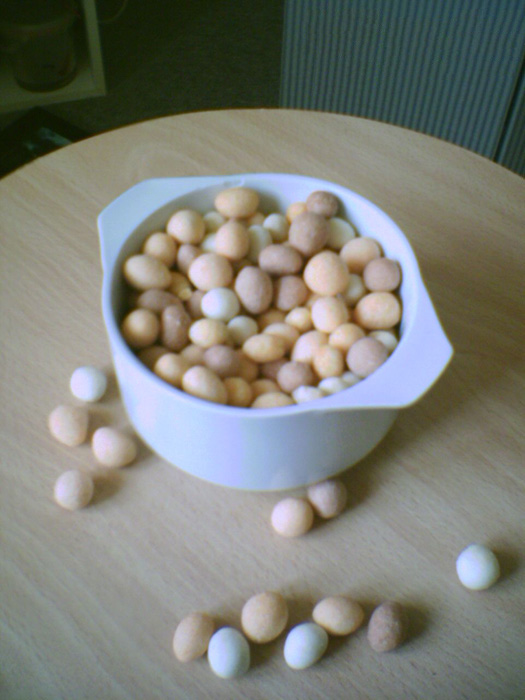|
Borrelnootje
A borrelnootje (English: roughly "cocktail nut") is a nut (often a peanut) with a crispy coating surrounding it, usually with a herbal flavour. It is mainly consumed in the Netherlands. Origin In the 1950s, the company Go & Zoon (later Go-Tan) made peanuts with a crispy outside. They marketed it as "Katjang Shanghai". This family-owned company introduced the nuts from Indonesia, where it is known as ''kacang pedis'' (spicy peanuts). The nuts were imitated by companies such as Calvé and Duyvis. Calvé paid patent rights to Go-Tan for the idea of mass-producing the nuts, whilst Duyvis invented their way of production. Preparation The layer around the cocktail nut consists mainly of starch. Depending on which type of nut, the nut will often be loose from the surround layer. This phenomenon could be a result of dough surround the nut rising, or due to moisture in the dough evaporating causing a decrease in volume. Variations The cocktail nut comes in several variations: * The ... [...More Info...] [...Related Items...] OR: [Wikipedia] [Google] [Baidu] |
Duyvis
Duyvis is a Dutch brand of salty snacks, peanuts and nuts. Dip sauces are also sold under the Duyvis brand. History The Duyvis name is attested since the 16th century in the Zaanstreek. In 1806, Teewis Duyvis (1757–1832), member of an anabaptist family of Oostzaandam inherited from his uncle the oil windmill near the Zaanse Schans, where it was built in 1670 and is still operational. Oil mills were used in the production of cattle-fodder with linseed oil as a by-product. The grandson of Teewis, who was also called Teewis (1825–1875), took over the company in 1850. The company expanded with several oil mills and was called Teewis Duyvis Jansz, after the grandson of the first Teewis. At one point Duyvis owns seven windmills, primarily in Koog aan de Zaan. In 1880 Ericus Gerardus Duyvis, son of the second Teewis, built a steam oil factory and still produced mainly cattle-fodder. As of 1908 the company started exporting linseed oil and in 1920 it started to refine the oil. Be ... [...More Info...] [...Related Items...] OR: [Wikipedia] [Google] [Baidu] |
Japanese-style Peanuts
Japanese-style peanuts, also known as Japanese peanuts or cracker nuts, are a type of snack food made from peanuts that are coated in a wheat flour dough and then fried or deep-fried. They come in a variety of different flavours. This type of snack is claimed to have originated in Mexico in the 1940s where a Japanese immigrant by the name of Yoshigei Nakatani invented “Japanese peanuts” (widely known in the Spanish-speaking world as ''cacahuates Japoneses'' or ''maní Japonés''). The Mexican version’s recipe for the extra-crunchy shell has ingredients such as wheat flour, soy sauce, water, sugar, monosodium glutamate, and citric acid. Similar foods Chinese Indonesian Frans Go established the Netherlands based company Go & Zoon (later Go-Tan) and began manufacturing ''borrelnootje'', peanuts coated in a crisp starch-based shell, under the name Katjang Shanghai (Shanghai nuts) in the 1950s. Thai snack food company Mae-Ruay started producing peanuts fried in a wheat flour-b ... [...More Info...] [...Related Items...] OR: [Wikipedia] [Google] [Baidu] |
Peanut
The peanut (''Arachis hypogaea''), also known as the groundnut, goober (US), pindar (US) or monkey nut (UK), is a legume crop grown mainly for its edible Seed, seeds. It is widely grown in the tropics and subtropics, important to both small and large commercial producers. It is classified as both a grain legume and, due to its high oil content, an oil crop. World annual production of shelled peanuts was 44 million tonnes in 2016, led by China with 38% of the world total. Atypically among legume crop plants, peanut pods develop underground (geocarpy) rather than above ground. With this characteristic in mind, the botanist Carl Linnaeus gave peanuts the specific epithet ''hypogaea'', which means "under the earth." The peanut belongs to the botanical Family (biology), family Fabaceae (or Leguminosae), commonly known as the legume, bean, or pea family. Like most other legumes, peanuts harbor symbiotic Nitrogen fixation, nitrogen-fixing bacteria in root nodules. The capacity to fi ... [...More Info...] [...Related Items...] OR: [Wikipedia] [Google] [Baidu] |
Snack Foods
A snack is a small portion of food generally eaten between meals. Snacks come in a variety of forms including packaged snack foods and other processed foods, as well as items made from fresh ingredients at home. Traditionally, snacks are prepared from ingredients commonly available at home without a great deal of preparation. Often cold cuts, fruits, leftovers, nuts, sandwiches, and sweets are used as snacks. With the spread of convenience stores, packaged snack foods became a significant business. Snack foods are typically designed to be portable, quick, and satisfying. Processed snack foods, as one form of convenience food, are designed to be less perishable, more durable, and more portable than prepared foods. They often contain substantial amounts of sweeteners, preservatives, and appealing ingredients such as chocolate, peanuts, and specially-designed flavors (such as flavored potato chips). A snack eaten shortly before going to bed or during the night may be c ... [...More Info...] [...Related Items...] OR: [Wikipedia] [Google] [Baidu] |


